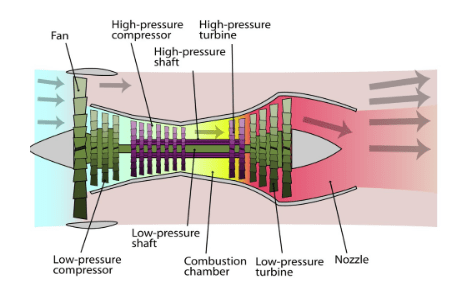Turbofan engines are among the most common types of engines used in aircraft today, offering an efficient and powerful solution for modern aviation. Here's a detailed look at how these engines work, supported by citations to ensure accuracy and credibility.
Basic Structure and Function
A turbofan engine consists of a fan, compressor, combustor, turbine, and nozzle. It operates by drawing air in through the fan, with some air bypassing the core to reduce noise and increase efficiency. The remaining air passes through the compressor, gets mixed with fuel in the combustor, and is ignited. The resulting hot gas expands through the turbine, which drives the compressor and fan, before exiting through the nozzle to provide thrust. [source: The Difference Between Turbojet and Turbofan Engines Explained (hangar.flights)].

Air Intake
The operation begins with air entering the engine through the fan. A significant portion of this air bypasses the core of the engine, providing thrust directly from its passage through the ducts surrounding the engine, which is much quieter than the exhaust from the core.
Compression Stage
Once the air enters the engine, it passes through multiple compressor stages. These stages consist of alternating rows of rotating blades and stationary vanes, which progressively compress the incoming air, increasing its pressure and temperature before it enters the combustion chamber.
Combustion and Energy Release
In the combustion chamber, the high-pressure air mixes with fuel and is ignited. This combustion process significantly increases the temperature and energy of the airflow. The high-energy gas then exits the combustion chamber and enters the turbine.
Turbine and Exhaust
The turbine is made up of stages similar to those in the compressor but operates in reverse; it extracts energy from the high-speed, high-pressure gas flowing out of the combustor. This extracted energy is primarily used to power the fan and the compressors. The gas that exits the turbine is expelled through the nozzle at the back, producing a jet of exhaust that provides additional thrust.
Efficiency and Noise Reduction
One of the significant advantages of turbofan engines over other types is their efficiency at lower speeds, which makes them ideal for commercial airliners. The bypassed air reduces fuel consumption and noise, which is a critical factor in their widespread use.
Environmental Impact
Turbofan engines are also designed to minimize environmental impact. Innovations in engine design continue to focus on reducing emissions and increasing fuel efficiency, which is vital for sustainable aviatio.
In summary, the turbofan engine is a complex piece of machinery that has evolved significantly since its inception. Its design cleverly uses the principles of aerodynamics, thermodynamics, and mechanical engineering to provide a balance of power, efficiency, and environmental consideration, making it the backbone of modern air transport.
For a closer look at turbofan engines, consider exploring our detailed models at Mech Artisans. Each model offers a hands-on experience to enhance your understanding of their complex mechanics and design. Check out the images at the end of this article for more insights.




